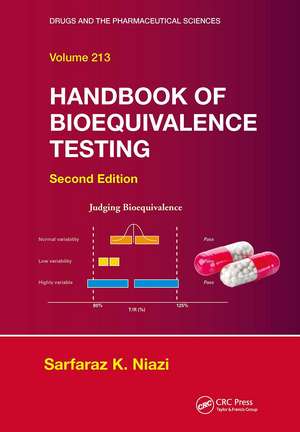Handbook of Bioequivalence Testing: Drugs and the Pharmaceutical Sciences
Autor Sarfaraz K. Niazien Limba Engleză Paperback – 14 oct 2024
New topics include:
- A historical perspective on generic pharmaceuticals
- New guidelines governing submissions related to bioequivalency studies, along with therapeutic code classifications
- Models of noninferiority
- Biosimilarity of large molecule drugs
- Bioequivalence of complementary and alternate medicines
- Bioequivalence of biosimilar therapeutic proteins and monoclonal antibodies
- New FDA guidelines for bioanalytical method validation
- Outsourcing and monitoring of bioequivalence studies
Din seria Drugs and the Pharmaceutical Sciences
- 9%
 Preț: 934.94 lei
Preț: 934.94 lei - 8%
 Preț: 547.38 lei
Preț: 547.38 lei - 9%
 Preț: 1315.61 lei
Preț: 1315.61 lei - 5%
 Preț: 569.76 lei
Preț: 569.76 lei -
 Preț: 493.90 lei
Preț: 493.90 lei - 9%
 Preț: 1495.13 lei
Preț: 1495.13 lei - 9%
 Preț: 574.12 lei
Preț: 574.12 lei -
 Preț: 362.51 lei
Preț: 362.51 lei - 18%
 Preț: 1544.82 lei
Preț: 1544.82 lei - 12%
 Preț: 312.43 lei
Preț: 312.43 lei -
 Preț: 432.29 lei
Preț: 432.29 lei -
 Preț: 473.10 lei
Preț: 473.10 lei - 25%
 Preț: 1029.60 lei
Preț: 1029.60 lei -
 Preț: 419.35 lei
Preț: 419.35 lei - 26%
 Preț: 989.34 lei
Preț: 989.34 lei - 18%
 Preț: 1287.55 lei
Preț: 1287.55 lei - 24%
 Preț: 732.04 lei
Preț: 732.04 lei - 18%
 Preț: 1131.57 lei
Preț: 1131.57 lei - 15%
 Preț: 493.70 lei
Preț: 493.70 lei - 26%
 Preț: 1043.76 lei
Preț: 1043.76 lei - 29%
 Preț: 1018.82 lei
Preț: 1018.82 lei - 18%
 Preț: 783.69 lei
Preț: 783.69 lei - 22%
 Preț: 403.86 lei
Preț: 403.86 lei - 21%
 Preț: 361.46 lei
Preț: 361.46 lei - 18%
 Preț: 1344.36 lei
Preț: 1344.36 lei - 25%
 Preț: 1231.76 lei
Preț: 1231.76 lei - 27%
 Preț: 995.07 lei
Preț: 995.07 lei - 27%
 Preț: 999.16 lei
Preț: 999.16 lei - 15%
 Preț: 508.28 lei
Preț: 508.28 lei - 18%
 Preț: 1285.17 lei
Preț: 1285.17 lei - 18%
 Preț: 909.35 lei
Preț: 909.35 lei - 29%
 Preț: 1113.70 lei
Preț: 1113.70 lei - 15%
 Preț: 469.23 lei
Preț: 469.23 lei - 18%
 Preț: 1544.03 lei
Preț: 1544.03 lei - 15%
 Preț: 585.27 lei
Preț: 585.27 lei - 31%
 Preț: 682.94 lei
Preț: 682.94 lei - 29%
 Preț: 1191.13 lei
Preț: 1191.13 lei - 15%
 Preț: 461.03 lei
Preț: 461.03 lei - 27%
 Preț: 1049.91 lei
Preț: 1049.91 lei - 18%
 Preț: 1584.73 lei
Preț: 1584.73 lei - 18%
 Preț: 1830.13 lei
Preț: 1830.13 lei - 18%
 Preț: 1342.79 lei
Preț: 1342.79 lei - 18%
 Preț: 1278.08 lei
Preț: 1278.08 lei - 18%
 Preț: 1346.72 lei
Preț: 1346.72 lei - 18%
 Preț: 1273.35 lei
Preț: 1273.35 lei
Preț: 341.84 lei
Preț vechi: 371.48 lei
-8% Nou
Puncte Express: 513
Preț estimativ în valută:
65.41€ • 68.47$ • 54.44£
65.41€ • 68.47$ • 54.44£
Carte tipărită la comandă
Livrare economică 31 martie-14 aprilie
Preluare comenzi: 021 569.72.76
Specificații
ISBN-13: 9781032917351
ISBN-10: 1032917350
Pagini: 1008
Ilustrații: 39
Dimensiuni: 178 x 254 mm
Greutate: 1.86 kg
Ediția:2
Editura: CRC Press
Colecția CRC Press
Seria Drugs and the Pharmaceutical Sciences
Locul publicării:Boca Raton, United States
ISBN-10: 1032917350
Pagini: 1008
Ilustrații: 39
Dimensiuni: 178 x 254 mm
Greutate: 1.86 kg
Ediția:2
Editura: CRC Press
Colecția CRC Press
Seria Drugs and the Pharmaceutical Sciences
Locul publicării:Boca Raton, United States
Public țintă
Academic and Professional Practice & DevelopmentNotă biografică
Sarfaraz K. Niazi, PhD, is the chairman and CEO of Therapeutic Proteins International, a world-class developer and manufacturer of biosimilar recombinant drugs. The company now leads the world in using innovative methods of manufacturing biosimilar recombinant drugs coming off-patents. He employs hundreds of world’s top scientists working toward the goal of making life-saving biological drugs more affordable. He has published over 100 refereed research articles and abstracts, dozens of books, and hundreds of literary writings that span the vast areas of poetry, philosophy, rhetoric, irony, and modern dilemma.
Recenzii
"This handbook offers a complete description of every aspect of bioequivalence testing … [It] is an essential, one-of-a-kind resource for anyone interested in bioequivalence. There are no other books that compile so many aspects in one place."
—Jennifer L. Colon, PharmD, Temple University School of Pharmacy, in Doody’s Review Service
—Jennifer L. Colon, PharmD, Temple University School of Pharmacy, in Doody’s Review Service
Cuprins
Historical Perspective on Generic Pharmaceuticals. Physicochemical Basis of Bioequivalence Testing. Drug Delivery Factors. Pharmacokinetic/Pharmacodynamic (PK/PD) Modeling. Bioequivalence Testing Rationale and Principles. Bioequivalence Waivers. Statistical Evaluation of Bioequivalence Data. Regulatory Inspection Process. Fed Bioequivalence Studies. Topical Drugs. Bioequivalence of Nasal Products. Bioequivalence of Complementary and Alternate Medicines. Bioequivalence of Biosimilar Products. Bioequivalence Testing: The US Perspective. Bioequivalence Testing: European Perspective. Bioequivalence Testing: The ROW Perspective. Bioequivalence Testing Protocols. Bioequivalence Documentation. Good Laboratory Practices. Bioanalytical Method Validation. Good Clinical Practice. Computer and Software Validation. Outsourcing and Monitoring of Bioequivalence Studies. Epilogue: Future of Bioequivalence Testing. Appendix A: Glossary of Terms. Appendix B: Dissolution Testing Requirements for US FDA Submission. Bibliography. Index.
Descriere
In recent years, there have been significant changes to the statistical models for evaluating bioequivalence. In addition, advances in the analytical technology used to detect drug and metabolite levels have made bioequivalence testing more complex. The second edition of this book has been completely updated to include the most current informati
